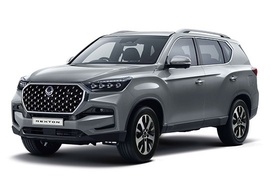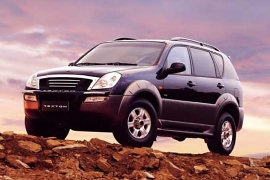
SSANGYONG Rexton
Generations Timeline, Specs and Pictures

SsangYong revived the Rexton range with a significant facelift in 2021, which included changes in all areas, improving the company’s flagship.
After 65 years, the Korean carmaker was already experienced in the offroad segment, and its products were good enough for its price range. Its main problems were the name, which was difficult to spell by most people, and the dealer’s network, which were scattered around the world but without too much consistency. During the world financial crisis, the carmaker ended-up being bought by the Indian group Mahindra&Mahindra, which was also experienced in building offroad vehicles.
In 2017, SsangYong introduced the second generation of the Rexton, which was also known as the G4. It was still built on a chassis, but the design was a big step forward from its predecessor. The 2021 model was even bolder, with a new 3D mesh-grille design surrounded by a chromed, octagonal rim. Its new headlights were available as an option with LED.
Inside, the carmaker completely changed the dashboard and included a 12.3” TFT display for the instrument panel. For the infotainment unit, SsangYong installed a standard 8” touch-screen, while a 9” display with TomTom navigation was fitted as standard on the full-option version. Both systems featured wireless Android Auto and Apple CarPlay.
Under the hood, SsangYong kept the same 2.2-liter turbo-diesel engine developed in-house and upgraded to pass the 200 hp barrier. It was paired with an eight-speed automatic transmission. The 4x4 on-demand system featured high and low gear for extreme offroad situations.

SsangYong retired the first generation of the Rexton from the market after 16 years and two facelifts and introduced a completely new model in 2018.
Between the first generation and the second, a lot of things happened to the Korean carmaker, and the biggest change was the ownership. The Indian group Mahindra&Mahindra acquired 70% of SsangYong’s shares in 2011 and saved it from bankruptcy. With their financial help, the Korean carmaker was back on track and developed the Rexton G4 from the ground up. It was still built in an old-school way with body-on-frame construction, but other than that, it was better in any way.
When Mahindra&Mahindra acquired Pininfarina Studios, it was too late to make any other changes for the car’s exterior, so it was left as the Korean designers made it. The massive flat front area and sculptured body panels offered a commanding look on the road. Its swept-back headlights and raked windshield offered a dynamic appearance. As part of the options list, a hands-free opening system was available for the tailgate.
While SsangYong couldn’t change the exterior, the interior benefited from some special advice from Pininfarina specialists. They installed quilted leather upholstery on the seats and dashboard. Depending on the level, the cabin featured metallic or wood-trims, and it was real wood, not plastic. Thanks to its big wheelbase, it offered plenty of room for five occupants with an option for a seven-seat cabin.
Under the hood, SsangYong installed a 2.2-liter turbo-diesel engine as its main version and a 2.0-liter turbocharged gasoline unit for selected markets. Both were paired as standard to a six-speed manual, while an automatic was available at extra cost.

Founded way back in 1939, the SsangYong Group became a great industrial company over the years, performing in many areas such as oil, paper, and others.
It was later in 1986 when they bought the Ha Dong Hwan Motor Company, a producer that sold trucks since 1954.
The Rexton was a strong competitors to the Kia Sorento and the Hyundai Terracan. The exterior design was rather boxy, but clean.
Inside the Rexton, the cabin offered an old-school layout, however, the controls were easy to operate and were intuitively positioned.
The comfortable seats along with the adjustable steering wheel provided the driver with a good driving position, great for journeys as well.
The Rexton could easy accommodate up to 5 adults, as its dimensions were close to a large SUV’s.
While advertised as a vehicle with a high quality finish interior, the plastics inside were not among the finest.
All trim levels came with dual airbags and side impact beams, as well as ABS, traction control, air-conditioning, a leather steering wheel, alloy wheels and roof rails.
Premium quality leather upholstery was available with the SE and the SX trim levels.
The Rexton was well known for its mechanical durability.
The Diesel engines were pretty noisy and were not very agile, options being a 2.7-liter engine that developed 162 hp, a 2.9-liter powerplant and the bigger 3.2-liter that produced 217 hp.

The Korean carmaker SsangYong tried to get a spot between the top off-road carmakers in the world and introduced the first generation of the Rexton in 2001.
With a design signed by Giugiaro and a drivetrain carried over from Mercedes-Benz, it shouldn’t be a problem. Yet, it was. Despite its bargain-priced vehicles, the SsangYong couldn’t make it too far on the market. Its name was utterly unknown and, moreover, it was more challenging to pronounce.
The Koreans didn’t know that if Giugiaro designed some successful vehicles, its design studio was not experienced in the 4x4 market. The result was a car that looked like a station wagon bolted on a chassis. Its body-on-frame construction was not that helpful either against other European SUVs. Its headlights swept back over the front fenders, and the broad chromed grille didn’t impress the customers.
Inside, the carmaker tried to offer luxurious packages such as the leather upholstery, the wood trims on the dashboard, door panels, and center stack. It provided an option for seven seats, with jump seats in the trunk. But the interior room was small. It could barely match a compact-sized Skoda Octavia station wagon in terms of cargo space.
Under the bodywork, the Rexton featured a Mercedes-Benz drivetrain. The carmaker offered a choice of gasoline and diesel engines paired to a five-speed manual or a five-speed automatic gearbox. Its two-speed transfer case was an excellent help while off-roading, but its rigid rear axle was not the best solution for a street vehicle.























































